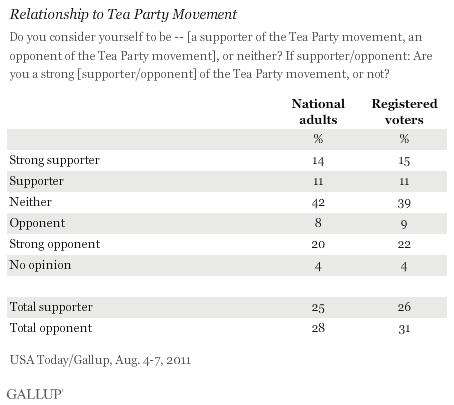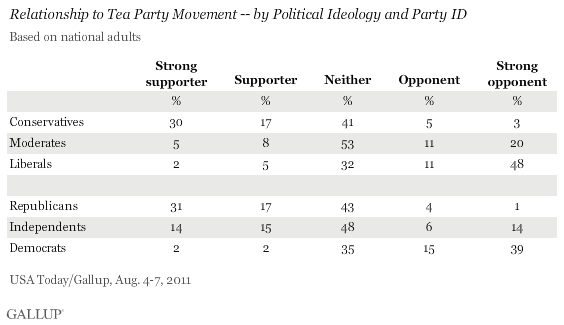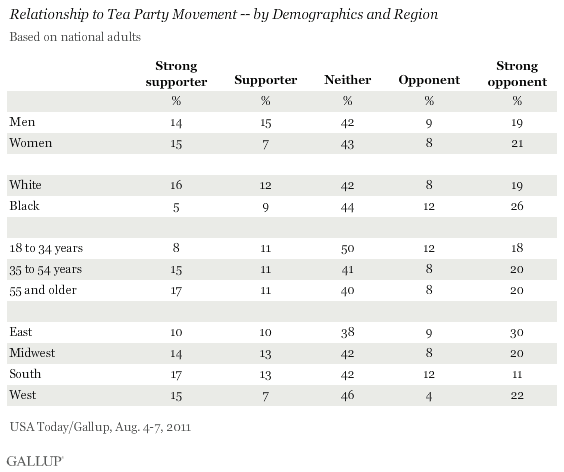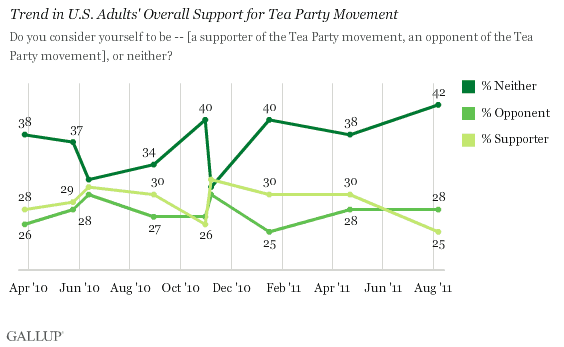PRINCETON, NJ -- More Americans consider themselves strong opponents of the Tea Party movement than strong supporters, by 20% to 14%, and the ratio is a similar 22% to 15% among registered voters. When factoring in those who support or oppose the movement but not strongly, the opposing groups are more evenly matched, with 25% of Americans in total classified as Tea Party supporters and 28% as opponents. About 4 in 10 Americans as well as registered voters say they neither support nor oppose the Tea Party.

Gallup has previously measured support for the Tea Party movement, but this is the first time it asked a follow-up question that probes intensity.
One of the more striking findings of the Aug. 4-7 USA Today/Gallup poll is that nearly half of self-described liberals, 48%, consider themselves strong opponents of the Tea Party, significantly greater than the 30% of conservatives calling themselves strong supporters. Similarly, by 39% to 31%, there are more strong Democratic opponents than strong Republican supporters. Among independents, 14% are strong supporters and an equal number are strong opponents.

Adults 35 and older are slightly more likely to call themselves strong supporters of the Tea Party movement than are those 18 to 34. Also, consistent with racial differences in party identification, whites are more supportive than blacks of the Tea Party. Gallup finds little difference between men's and women's relationship to the movement.
Residents of the East are less likely than those in other regions to be strong Tea Party supporters, and the East has the highest percentage of strong opponents. The South, however, is the only region where strong supporters outnumber strong opponents (17% vs. 11%).

Tea Party Support Dips to New Low
At 25%, overall support for the Tea Party among U.S. adults is similar to the previous low of 26% found in October 2010. Support increased to 32% last November -- immediately after the 2010 midterm elections -- and held at 30% in January and April of this year before dropping to the current new low.
Overall opposition to the Tea Party movement, now 28%, is about average for where it has been since early 2010, while the 42% saying they are neither supporters nor opponents is a new high.

Bottom Line
The national Tea Party movement appears to have lost some ground in popular support after the blistering debate over raising the nation's debt ceiling in which Tea Party Republicans in the U.S. House and Senate fought any compromise on taxes and spending. Fourteen percent of Americans consider themselves strong supporters of the Tea Party movement, and, perhaps not coincidentally, 12% of the public consists of conservative Republicans who wanted members of Congress who shared their views on the budget to hold out for a deal they could agree with. That is according to a July 15-17 Gallup poll on the debt ceiling debate.
Along with the decline in overall support for the Tea Party from 30% to 25% in recent months, Gallup finds more Americans holding intensely negative feelings toward the movement than intensely positive feelings. It thus appears that, to date, the Tea Party's leadership and activities may have been more successful at galvanizing the movement's opponents than expanding its base of passionate supporters.
Survey Methods
Results for this USA Today/Gallup poll are based on telephone interviews conducted Aug. 4-7, 2011, with a random sample of 1,319 adults, aged 18 and older, living in all 50 U.S. states and the District of Columbia. The survey includes an oversample of 376 non-Hispanic blacks, consisting of 88 interviews done as part of the random national sample and 288 interviews with blacks who had previously participated in national Gallup Polls and agreed to be re-interviewed at a later date. The data from the national sample and re-interviews are combined and weighted to be demographically representative of the national adult population in the United States and to reflect the proper proportion of blacks in the overall population.
For results based on the total sample of national adults, one can say with 95% confidence that the maximum margin of sampling error is ±4 percentage points.
For results based on the sample of 376 non-Hispanic blacks, the maximum margin of error is ±6 percentage points.
For results based on the sample of 796 non-Hispanic whites, the maximum margin of error is ±5 percentage points.
Interviews are conducted with respondents on landline telephones and cellular phones, with interviews conducted in Spanish for respondents who are primarily Spanish-speaking. Each sample includes a minimum quota of 400 cell phone respondents and 600 landline respondents per 1,000 national adults, with additional minimum quotas among landline respondents by region. Landline telephone numbers are chosen at random among listed telephone numbers. Cell phone numbers are selected using random-digit-dial methods. Landline respondents are chosen at random within each household on the basis of which member had the most recent birthday.
Samples are weighted by gender, age, race, Hispanic ethnicity, education, region, adults in the household, and phone status (cell phone only/landline only/both, cell phone mostly, and having an unlisted landline number). Demographic weighting targets are based on the March 2010 Current Population Survey figures for the aged 18 and older non-institutionalized population living in U.S. telephone households. All reported margins of sampling error include the computed design effects for weighting and sample design.
In addition to sampling error, question wording and practical difficulties in conducting surveys can introduce error or bias into the findings of public opinion polls.
View methodology, full question results, and trend data.
For more details on Gallup's polling methodology, visit www.gallup.com.
